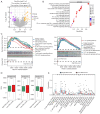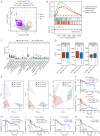Radiomicsmetabolic signature profiles for advanced non-small cell lung cancer with chemoimmunotherapy by reflecting biological function and survival
- PMID: 39830771
- PMCID: PMC11736617
- DOI: 10.21037/tlcr-24-576
Radiomicsmetabolic signature profiles for advanced non-small cell lung cancer with chemoimmunotherapy by reflecting biological function and survival
Abstract
Background: Resistance to chemoimmunotherapy in patients with advanced non-small cell lung cancer (NSCLC) necessitates effective prognostic biomarkers. Although 18F-fluorodeoxyglucose (FDG) positron emission tomography (PET)/computed tomography (CT) has shown potential for efficacy assessment, it has been mainly evaluated in immuno-monotherapy setting, lacking elaborations in the scenarios of immunotherapy combined with chemotherapy. To tackle this dilemma, we aimed to build a non-invasive PET/CT-based model for stratifying tumor heterogeneity and predicting survival in advanced NSCLC patients undergoing chemoimmunotherapy. Meanwhile, we explored the interplay and combined effect between programmed death-ligand 1 (PD-L1) and metabolic parameters and probed into the prognostic differences between patients with similar total metabolic tumor volume (tMTV) but different tumor distribution (lesion locations and numbers).
Methods: We retrospectively recruited unresectable advanced NSCLC patients receiving immunotherapy in Jinling Hospital from 2018 to 2023 as the training cohort. The Cancer Imaging Archive (TCIA) cohort with early-stage NSCLC patients undergoing surgical resection was used for validation and the assessment of the biological function and tumor microenvironment (TME). PET/CT-based parameters were extracted, including radiomics score (Rad-score), bone marrow to liver ratio (BLR), tMTV, and total lesion glycolysis (TLG). The end-point events included overall survival (OS) and progression-free survival (PFS). Step-wise multivariate Cox regression and the least absolute shrinkage and selection operator (LASSO) were used to identify candidate variables and establish models.
Results: A total of 220 patients were identified for analysis, including 139 with unresectable advanced NSCLC receiving immunotherapy and 81 from TCIA. The Radiomicsmetabolicos model for OS encompassing Rad-score >0.705 [hazard ratio (HR) =2.455; 95% confidence interval (CI): 1.324-4.550], squamous cell subtype (HR =1.641; 95% CI: 0.900-2.992), liver metastases (HR =3.496; 95% CI: 1.435-8.517), BLR >0.94 (HR =1.885; 95% CI: 1.013-3.507), and tMTV >105 mL (HR =2.162; 95% CI: 1.134-4.119) exhibited reliable prognostic capacity with a notable 3-year area under the curve (AUC) of 0.837. Patients with Rad-score ≤0.705 demonstrated upregulation of immune-related pathways and favorable survival. Additionally, distant metastases metabolic tumor volume (MTV) and TLG, as well as intrathoracic lymph nodes MTV were associated with survival independently. For patients with similar tMTV (≤105 mL), the number of FDG-avid lesions was an independent protective factor for more-than-1-year OS, which indicated that patients with smaller lesions seemed to have better long-term prognoses than those with larger lesions, even of fewer in number.
Conclusions: Our findings proved that PET/CT could reveal survival and tumor heterogeneity in advanced NSCLC patients undergoing chemoimmunotherapy, which might guide the selection of immune-monotherapy for low-risk patients and facilitate the advancement of precision treatment.
Keywords: Fluorodeoxyglucose positron emission tomography (FDG PET); immunotherapy; non-small cell lung cancer (NSCLC); radiomics; tumor microenvironment (TME).
2024 AME Publishing Company. All rights reserved.
Conflict of interest statement
Conflicts of Interest: All authors have completed the ICMJE uniform disclosure form (available at https://tlcr.amegroups.com/article/view/10.21037/tlcr-24-576/coif). Y.S. serves as an Editor-in-Chief of Translational Lung Cancer Research. The other authors have no conflicts of interest to declare.
Figures







Similar articles
-
The role of baseline 18F-FDG PET/CT for survival prognosis in NSCLC patients undergoing immunotherapy: a systematic review and meta-analysis.Ther Adv Med Oncol. 2024 Nov 4;16:17588359241293364. doi: 10.1177/17588359241293364. eCollection 2024. Ther Adv Med Oncol. 2024. PMID: 39502406 Free PMC article. Review.
-
[18F]FDG PET-CT radiomics signature to predict pathological complete response to neoadjuvant chemoimmunotherapy in non-small cell lung cancer: a multicenter study.Eur Radiol. 2024 Jul;34(7):4352-4363. doi: 10.1007/s00330-023-10503-8. Epub 2023 Dec 21. Eur Radiol. 2024. PMID: 38127071
-
The Value of 18F-FDG PET/CT in Predicting the Response to PD-1 Blocking Immunotherapy in Advanced NSCLC Patients with High-Level PD-L1 Expression.Clin Lung Cancer. 2021 Sep;22(5):432-440. doi: 10.1016/j.cllc.2021.03.001. Epub 2021 Mar 20. Clin Lung Cancer. 2021. PMID: 33879398
-
Baseline total metabolic tumour volume on 2-deoxy-2-[18F]fluoro-d-glucose positron emission tomography-computed tomography as a promising biomarker in patients with advanced non-small cell lung cancer treated with first-line pembrolizumab.Eur J Cancer. 2021 Jun;150:99-107. doi: 10.1016/j.ejca.2021.03.020. Epub 2021 Apr 20. Eur J Cancer. 2021. PMID: 33892411
-
Prognostic value of 18F-FDG PET/CT in patients with advanced or metastatic non-small-cell lung cancer treated with immune checkpoint inhibitors: A systematic review and meta-analysis.Front Immunol. 2022 Nov 17;13:1014063. doi: 10.3389/fimmu.2022.1014063. eCollection 2022. Front Immunol. 2022. PMID: 36466905 Free PMC article.
References
-
- Dall'Olio FG, Calabrò D, Conci N, et al. Baseline total metabolic tumour volume on 2-deoxy-2-[18F]fluoro-d-glucose positron emission tomography-computed tomography as a promising biomarker in patients with advanced non-small cell lung cancer treated with first-line pembrolizumab. Eur J Cancer 2021;150:99-107. - PubMed
LinkOut - more resources
Full Text Sources
Research Materials
